Topics
Category
Era
3M (Minnesota Mining and Manufacturing Company)
Worker monitoring a machine inside the 3M plant in New Ulm, July 1974. Public domain. From the records of the Environmental Protection Agency (EPA), 1944–2006, National Archives record group 412.
From its early beginnings on Lake Superior’s North Shore to its legacy of innovative manufacturing in St. Paul, 3M—formerly known as the Minnesota Mining and Manufacturing Company—has introduced both consumer and industrial products that have been successfully marketed worldwide.
3M was founded in 1902 in Two Harbors, Minnesota. Prospectors were attracted to the reported wealth of minerals in northern Minnesota due to the rich deposits of iron ore found in the region. 3M’s founders sought to mine corundum, a material used in sandpaper. However, they found that their deposit contained the mineral anorthosite rather than corundum, and the mining plans were abandoned. After this setback, the company moved to nearby Duluth, where it sought to manufacture abrasive products. Lucius Ordway Jr. made huge investments in 3M and eventually encouraged the company to move its factory to St. Paul.
While Ordway’s constant “angel” investments rescued 3M from financial failure, new personnel were hired to invigorate the company and build relationships with customers. William McKnight, a bookkeeper at the company who later became president in 1929, spearheaded efforts to emphasize quality control. He also hired Archibald Bush to lead sales of 3M’s products. In 1916, 3M turned its first profit after creating its first unique product: Three-M-ite abrasive cloth. Following this long-awaited success, the company returned its first dividend to its shareholders.
In St. Paul, 3M management fostered a culture of innovation and scientific discovery. To encourage employees to develop new products, the company instituted a “15 percent rule,” which allowed scientists to spend 15 percent of their working hours on independent projects. Many of 3M’s most recognizable products were developed through independent study at 3M’s facilities. These include Sasheen ribbon, a decorating ribbon, and Tartan Track and Turf, the first artificial running track and turf ever developed. Another innovative 3M institution was the 3M Technical Forum, created in 1951. The forum was designed to allow technical employees of the company to collaborate, educate, and learn from other employees who often worked on wildly different products.
While the two most notable 3M consumer products are likely Scotch Tape and Post-it Notes, there are many other products that 3M has pioneered—some even by accident. In 1953, lab technicians Patsy Sherman and Joan Mullen were working on fluorochemical rubber particles when Mullen accidentally dropped a beaker of the fluid on her shoes. Finding it impossible to get the fluid off of Mullen’s shoes, Sherman found that this was an opportunity she could develop further. A few years later, Scotchgard fabric protector was introduced, and Sherman continued to improve the still-popular product throughout her career.
3M’s developments had far-reaching impacts on various industries, including office supplies and entertainment. 3M’s Thermo-Fax was the first photocopier produced, debuting in 1950. While more advanced photocopiers have since been developed, the Thermo-Fax revolutionized office productivity and communication. 3M also produced more than just masking tape in their Scotch Tape product line—Scotch Sound and Video Magnetic Recording Tapes both allowed music and television shows, respectively, to be pre-recorded rather than produced live. In the 1980s, 3M was even honored with Emmy and Academy Awards for their developments in magnetic film for videotapes and improvements in film soundtracks.
As 3M expanded into more industries, the company sought to enter the global market in the 1950s. 3M and its competitors created a joint corporation that could compete with foreign corporations, but this venture was soon dismantled due to anti-trust laws. 3M used components left over from that operation to streamline their own international network, and throughout the 1950s, 3M opened operations in twelve different countries. In the next decade, 3M opened operations in twenty-three more countries—at least one on every continent except Antarctica. This early and sustained expansion allowed 3M to strengthen its footing in a global market, and it helped make 3M one of America’s largest corporations.
While Scotch Tape and Post-it Notes might be 3M’s most recognizable products, the company has developed solutions for many different purposes and industries. Reflective street signs, specialized stoplights, Thinsulate thermal insulation, and Scotch-Brite cleaning pads are just a few of the many more innovations that have helped turn this fledgling mining company into a Fortune 500 global corporation.
Bibliography
3M Company. 100: A Century of Innovation. St. Paul: 3M Company, 2002.
3M Company. 3M History.
https://www.3m.com/3M/en_US/company-us/about-3m/history
Bloom, Loralee J. “Mining the Archives.” Minnesota History 58, no. 3 (Fall 2002): 162–167.
http://collections.mnhs.org/MNHistoryMagazine/articles/58/v58i03p162-167.pdf
Huck, Virginia. Brand of the Tartan: the 3M Story. New York: Appleton-Century-Crofts, 1955.
Minnesota Mining and Manufacturing Company [3M Company]. Our Story So Far: Notes from the First 75 Years at 3M. St. Paul: 3M Company, 1977.
Museum of Magnetic Sound Recording. 3M Manufacturer Profile.
https://museumofmagneticsoundrecording.org/Manufacturers3M.html
Related Resources
Primary
3M Company. 3M Today. St. Paul: 3M Company, 1993–2001. Periodical. Accessible at the Minnesota Historical Society library as HD9729.M5 T65.
3M Corporate Contributions Committee and 3M Foundation. 3M Contribution Program [Annual Report]. St. Paul: 3M Company, 1986.
3M historical corporate records, 1892–2010
Manuscripts Collection, Minnesota Historical Society, St. Paul
http://www.mnhs.org/library/findaids/00281.xml
Description: A collection of 3M’s corporate records from much of the corporation’s history in Minnesota.
Alvin Boese papers, 1940–1981
Manuscripts Collection, Minnesota Historical Society, St. Paul
http://www2.mnhs.org/library/findaids/p2093.xml
Description: A collection of Alvin Boese’s papers and business records from his career as a prominent researcher and inventor at 3M Company.
Minnesota Mining and Manufacturing Company. Annual Report. St. Paul: 3M Company, 1938–2002. Available at the Minnesota Historical Society library as HD9729.M5 A2.
Minnesota Mining and Manufacturing Company. Annual Report.M St. Paul: 3M Company, 2003–2013. Available at Minnesota Historical Society library as HD9729.M5 A3.
105.D.11.9B
Richard C. Brower files, 1949–1956
Minnesota Department of Education
State Archives Collection, Minnesota Historical Society, St. Paul
Description: Documents of Richard Brower, an audio-visual supervisor at 3M, who collected materials related to a Minnesota experimental tape recording project.
P1757
Richard G. Drew papers, 1921–1982
Manuscripts Collection, Minnesota Historical Society, St. Paul
Description: Correspondence and other materials of Richard G. Drew, a 3M employee known for inventing Scotch Tape. His obituary is also included.
Secondary
Fry, Art, and Spencer Silver. “First Person: ‘We Invented the Post-it Note.’” Financial Times. December 3, 2010.
https://www.ft.com/content/f08e8a9a-fcd7-11df-ae2d-00144feab49a#axzz18hyDnyKX
Gundling, Ernest. The 3M Way to Innovation: Balancing People and Profit. New York: Kodansha International, 2000.
Green, Penelope. “Post-it: The All-purpose Note That Stuck.” New York Times. July 7, 2007.
http://www.nytimes.com/2007/06/29/arts/29iht-postit.1.6413576.html
Kunz, Virginia Brainard. “The Financial Angel Who Rescued 3M: The Life and Times of Lucius Pond Ordway.” Ramsey County History 36, no. 3 (2001): 4–31.
Tenner, Edward. “The Dark Side of Sticky Notes.” The Atlantic. July 28, 2010. https://www.theatlantic.com/technology/archive/2010/07/the-dark-side-of-sticky-notes/60543
Thureen, Louise. “Birth of a Giant: 3M’s North Shore Heritage.” Lake Superior 14, no. 3 (1992): 38–43.
Web
Post-it Brand. History Timeline: Post-it Notes.
http://www.post-it.com/3M/en_US/post-it/contact-us/about-us
Scotchbrand. Timeline.
http://www.scotchbrand.com/3M/en_US/scotch-brand/about
Related Images
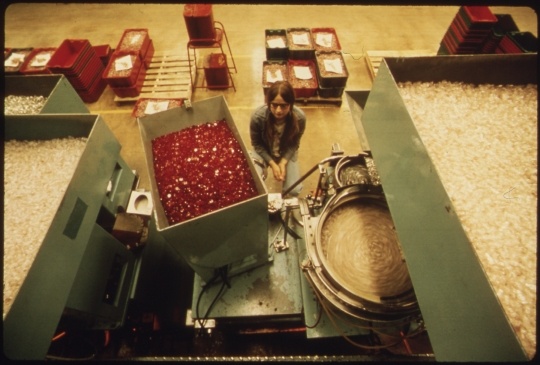
3M worker monitoring a machine
Worker monitoring a machine inside the 3M plant in New Ulm, July 1974. Public domain. From the records of the Environmental Protection Agency (EPA), 1944–2006, National Archives record group 412.
Holding Location
More Information
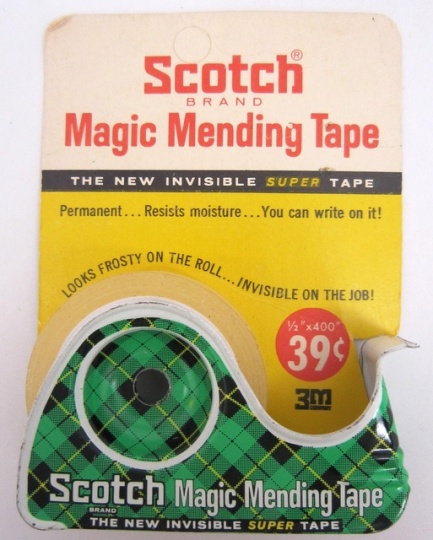
3M Scotch Tape
3M-brand Scotch Tape produced in the 1960s. The iconic brand became one of 3M’s most notable products.
All rights reserved
Holding Location
More Information
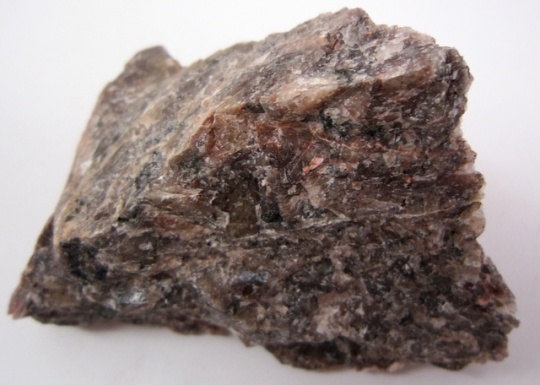
Anorthosite sample from Two Harbors, Minnesota
This sample of anorthosite was mined by 3M in the corporation’s earliest era. The corporation intended to mine corundum for sandpaper manufacturing, but anorthosite was found instead. This led to a transformation in the corporation’s structure and a transition from mining to manufacturing.
Holding Location
More Information
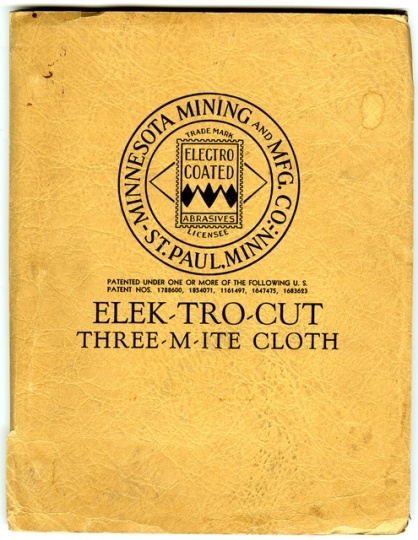
Three-M-ite sample collection
Three-M-ite sample collection, 1935. 3M’s first profitable product was Three-M-ite, a flexible sandpaper. Here, Three-M-ite was packaged as a sample so prospective buyers could see the product.
Holding Location
More Information
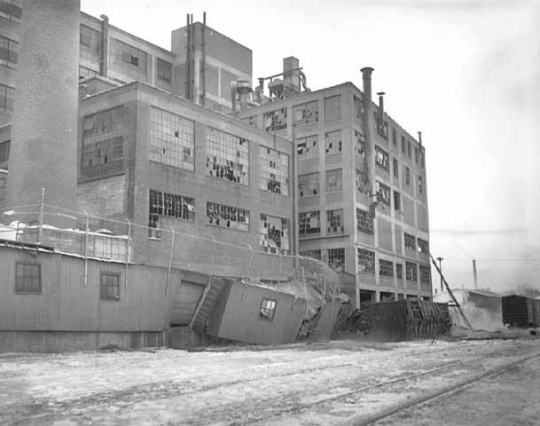
St. Paul’s 3M plant after an explosion
St. Paul’s 3M plant after an explosion, 1951. On February 8 of that year, a break in a gas line caused an explosion at 3M’s facility in St. Paul, killing thirteen employees and damaging various departments and laboratories throughout the complex.
Holding Location
More Information
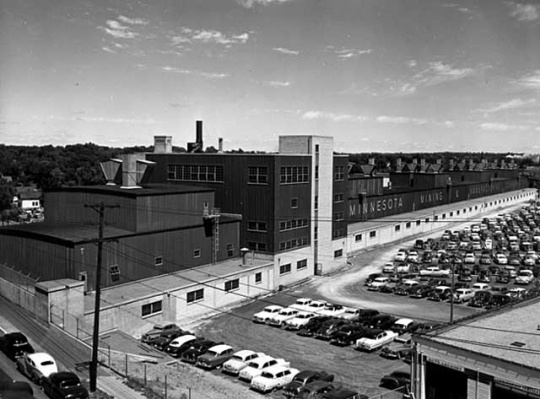
St. Paul Abrasives plant
St. Paul Abrasives plant, ca. 1955. Located on a large complex in St. Paul, the plant was one section of 3M’s global manufacturing headquarters.
Holding Location
More Information
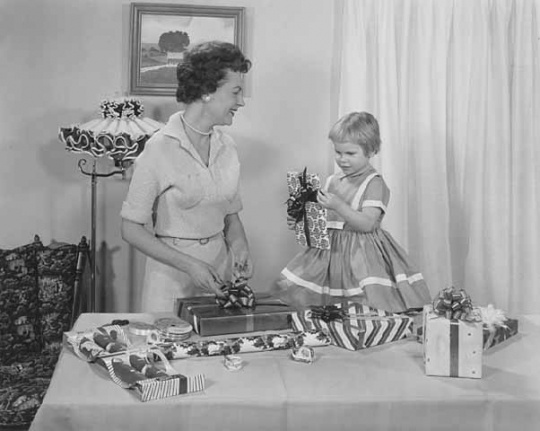
3M advertisement for Sasheen Ribbon
A mother and her daughter wrap gifts with Sasheen ribbon in this ca. 1955 advertisement for 3M.
Holding Location
More Information
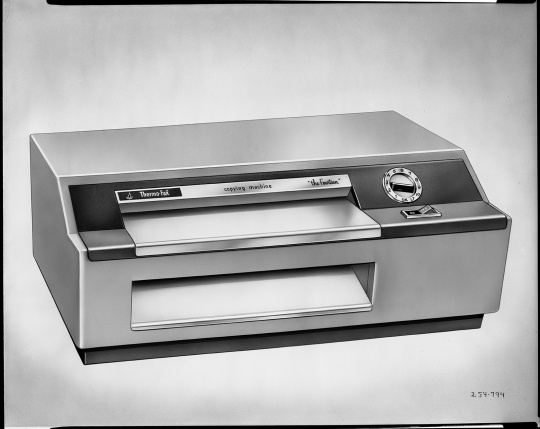
Thermo-Fax copying machine
Thermo-Fax copying machine, 1958. The Thermo-Fax was the first photocopier marketed in the United States. While it has since been made obsolete by more advanced products, it had major impacts on office communication.
Holding Location
More Information
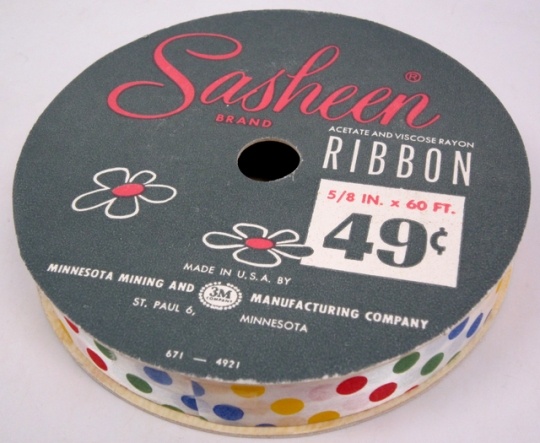
3M Sasheen Ribbon
3M’s Sasheen decorative ribbon, ca. 1960. The ribbon was created as a result of failed adhesive tape, and it helped expand the gift wrapping industry.
All rights reserved
Holding Location
More Information
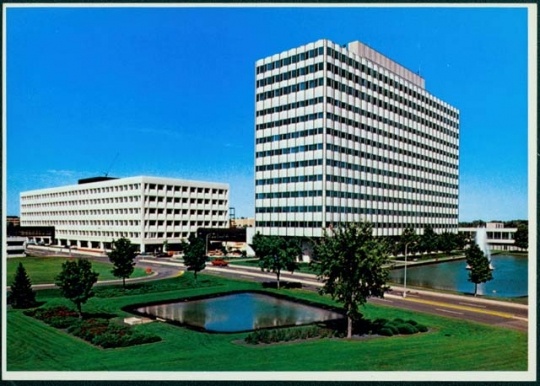
3M headquarters in Maplewood
3M headquarters in Maplewood, ca. 1960. Early in the 1960s, 3M moved their headquarters from St. Paul to nearby Maplewood, where they remain today.
Holding Location
More Information
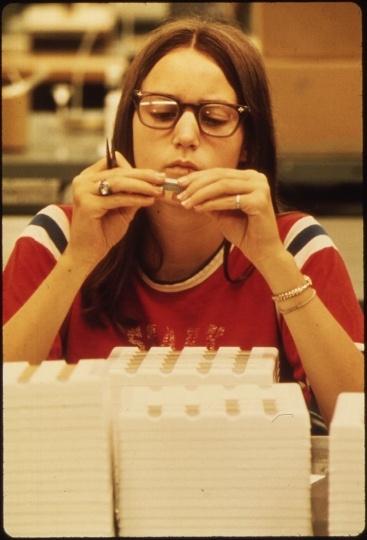
3M employee in New Ulm
3M employee at work in New Ulm, 1974. 3M had (and has, as of 2019) a factory in New Ulm that built electrical parts. Public domain.
Public domain
Holding Location
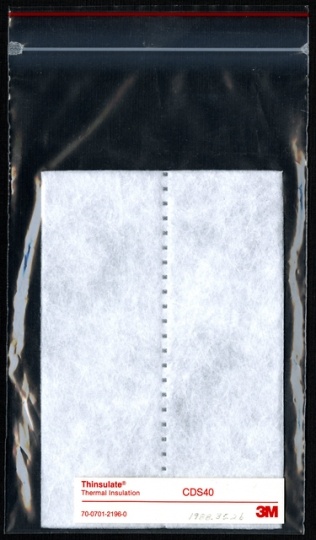
Thinsulate sample
Thinsulate sample, 1987. The material, a moveable thermal layer, revolutionized the active outerwear industry.
All rights reserved
Holding Location
More Information
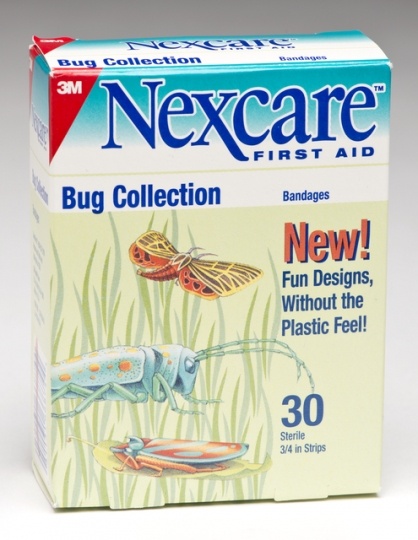
3M’s Nexcare bandages
3M’s Nexcare bandages, ca. 2001.
All rights reserved
Holding Location
More Information

3M factory water tower
3M factory water tower, ca. 2001. Water towers were a visible part of 3M’s large factory facilities. This water tower was located in Gorseinon, Wales, United Kingdom. Photograph by Wikimedia Commons user Nigel Davies.
Holding Location

3M headquarters in Maplewood
3M’s Maplewood headquarters in 2018. Photograph by Wikimedia Commons user Acroterion.
Holding Location
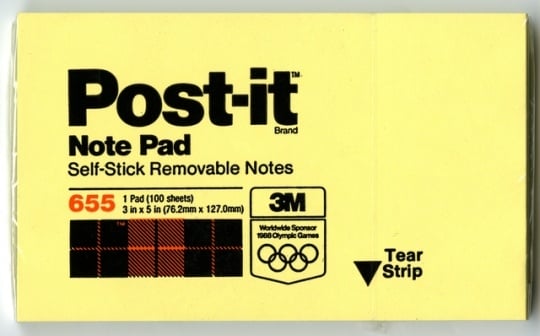
3M Post-it Notepad
An early version of a Post-it Note, 1986.
All rights reserved
Holding Location
More Information
Related Articles
Turning Point
On August 11, 1916, 3M finally emerges from debt after a rough fourteen years since incorporation. In those fourteen years, the company’s intended mineral deposit turned out to be useless, essential materials were damaged in transit, and sales were floundering or nonexistent. After the company introduces Three-M-ite, an abrasive cloth, the company makes a profit and pays dividends to its investors.
Chronology
1902
1905
1910
1916
1921
1925
1937
1946
1956
1961
1979
1980
2002
2018
Bibliography
3M Company. 100: A Century of Innovation. St. Paul: 3M Company, 2002.
3M Company. 3M History.
https://www.3m.com/3M/en_US/company-us/about-3m/history
Bloom, Loralee J. “Mining the Archives.” Minnesota History 58, no. 3 (Fall 2002): 162–167.
http://collections.mnhs.org/MNHistoryMagazine/articles/58/v58i03p162-167.pdf
Huck, Virginia. Brand of the Tartan: the 3M Story. New York: Appleton-Century-Crofts, 1955.
Minnesota Mining and Manufacturing Company [3M Company]. Our Story So Far: Notes from the First 75 Years at 3M. St. Paul: 3M Company, 1977.
Museum of Magnetic Sound Recording. 3M Manufacturer Profile.
https://museumofmagneticsoundrecording.org/Manufacturers3M.html
Related Resources
Primary
3M Company. 3M Today. St. Paul: 3M Company, 1993–2001. Periodical. Accessible at the Minnesota Historical Society library as HD9729.M5 T65.
3M Corporate Contributions Committee and 3M Foundation. 3M Contribution Program [Annual Report]. St. Paul: 3M Company, 1986.
3M historical corporate records, 1892–2010
Manuscripts Collection, Minnesota Historical Society, St. Paul
http://www.mnhs.org/library/findaids/00281.xml
Description: A collection of 3M’s corporate records from much of the corporation’s history in Minnesota.
Alvin Boese papers, 1940–1981
Manuscripts Collection, Minnesota Historical Society, St. Paul
http://www2.mnhs.org/library/findaids/p2093.xml
Description: A collection of Alvin Boese’s papers and business records from his career as a prominent researcher and inventor at 3M Company.
Minnesota Mining and Manufacturing Company. Annual Report. St. Paul: 3M Company, 1938–2002. Available at the Minnesota Historical Society library as HD9729.M5 A2.
Minnesota Mining and Manufacturing Company. Annual Report.M St. Paul: 3M Company, 2003–2013. Available at Minnesota Historical Society library as HD9729.M5 A3.
105.D.11.9B
Richard C. Brower files, 1949–1956
Minnesota Department of Education
State Archives Collection, Minnesota Historical Society, St. Paul
Description: Documents of Richard Brower, an audio-visual supervisor at 3M, who collected materials related to a Minnesota experimental tape recording project.
P1757
Richard G. Drew papers, 1921–1982
Manuscripts Collection, Minnesota Historical Society, St. Paul
Description: Correspondence and other materials of Richard G. Drew, a 3M employee known for inventing Scotch Tape. His obituary is also included.
Secondary
Fry, Art, and Spencer Silver. “First Person: ‘We Invented the Post-it Note.’” Financial Times. December 3, 2010.
https://www.ft.com/content/f08e8a9a-fcd7-11df-ae2d-00144feab49a#axzz18hyDnyKX
Gundling, Ernest. The 3M Way to Innovation: Balancing People and Profit. New York: Kodansha International, 2000.
Green, Penelope. “Post-it: The All-purpose Note That Stuck.” New York Times. July 7, 2007.
http://www.nytimes.com/2007/06/29/arts/29iht-postit.1.6413576.html
Kunz, Virginia Brainard. “The Financial Angel Who Rescued 3M: The Life and Times of Lucius Pond Ordway.” Ramsey County History 36, no. 3 (2001): 4–31.
Tenner, Edward. “The Dark Side of Sticky Notes.” The Atlantic. July 28, 2010. https://www.theatlantic.com/technology/archive/2010/07/the-dark-side-of-sticky-notes/60543
Thureen, Louise. “Birth of a Giant: 3M’s North Shore Heritage.” Lake Superior 14, no. 3 (1992): 38–43.
Web
Post-it Brand. History Timeline: Post-it Notes.
http://www.post-it.com/3M/en_US/post-it/contact-us/about-us
Scotchbrand. Timeline.
http://www.scotchbrand.com/3M/en_US/scotch-brand/about

















